Management Accounting Report: Cost and Budget Analysis, Unilever
VerifiedAdded on 2023/01/19
|16
|3491
|86
Report
AI Summary
This report delves into the core concepts of management accounting, emphasizing its role in cost estimation and financial reporting within organizations. Using Unilever as a case study, the report explores various aspects, including management accounting systems like cost accounting and inventory management. It analyzes different reporting methods such as budget reports, job cost reports, and performance reports, alongside techniques for product cost calculation using marginal and absorption costing. The report also evaluates the advantages and disadvantages of planning tools used in budgetary control, such as zero-based budgets, cash budgets, and operating budgets. It includes case studies and financial statements to illustrate the application of these concepts, concluding with an overview of how management accounting systems can be used to address financial problems.
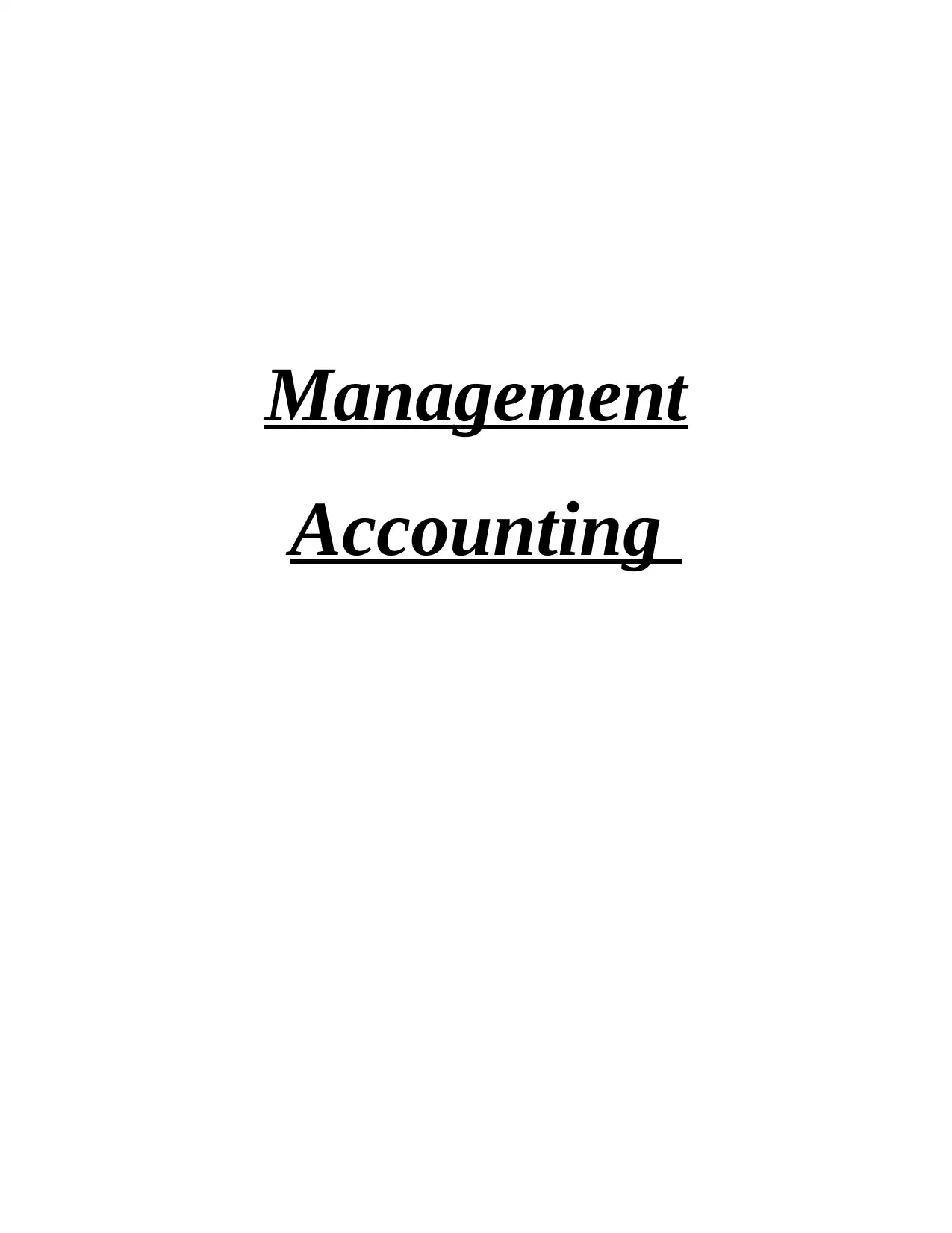
Management
Accounting
Accounting
Paraphrase This Document
Need a fresh take? Get an instant paraphrase of this document with our AI Paraphraser
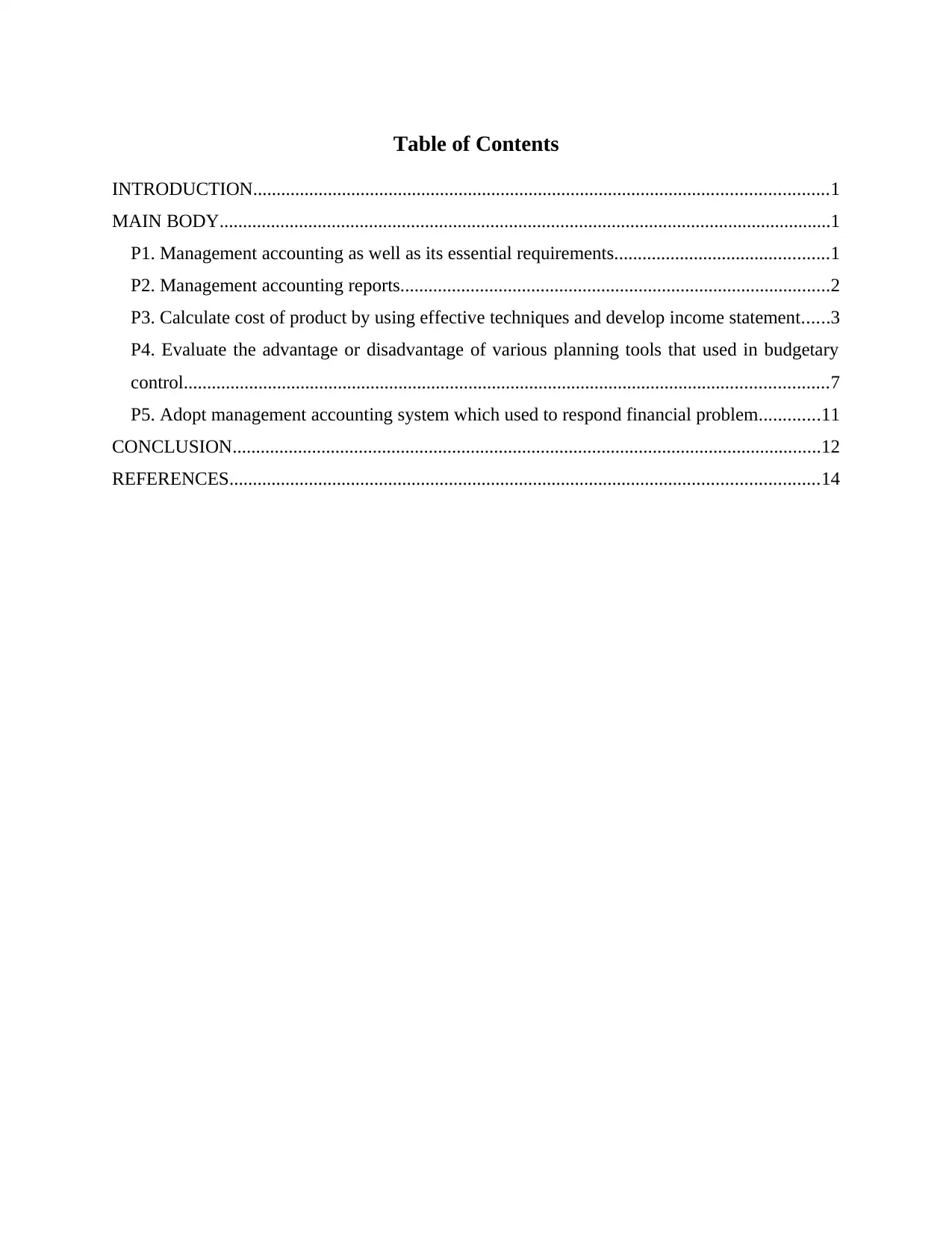
Table of Contents
INTRODUCTION...........................................................................................................................1
MAIN BODY...................................................................................................................................1
P1. Management accounting as well as its essential requirements..............................................1
P2. Management accounting reports............................................................................................2
P3. Calculate cost of product by using effective techniques and develop income statement......3
P4. Evaluate the advantage or disadvantage of various planning tools that used in budgetary
control..........................................................................................................................................7
P5. Adopt management accounting system which used to respond financial problem.............11
CONCLUSION..............................................................................................................................12
REFERENCES..............................................................................................................................14
INTRODUCTION...........................................................................................................................1
MAIN BODY...................................................................................................................................1
P1. Management accounting as well as its essential requirements..............................................1
P2. Management accounting reports............................................................................................2
P3. Calculate cost of product by using effective techniques and develop income statement......3
P4. Evaluate the advantage or disadvantage of various planning tools that used in budgetary
control..........................................................................................................................................7
P5. Adopt management accounting system which used to respond financial problem.............11
CONCLUSION..............................................................................................................................12
REFERENCES..............................................................................................................................14
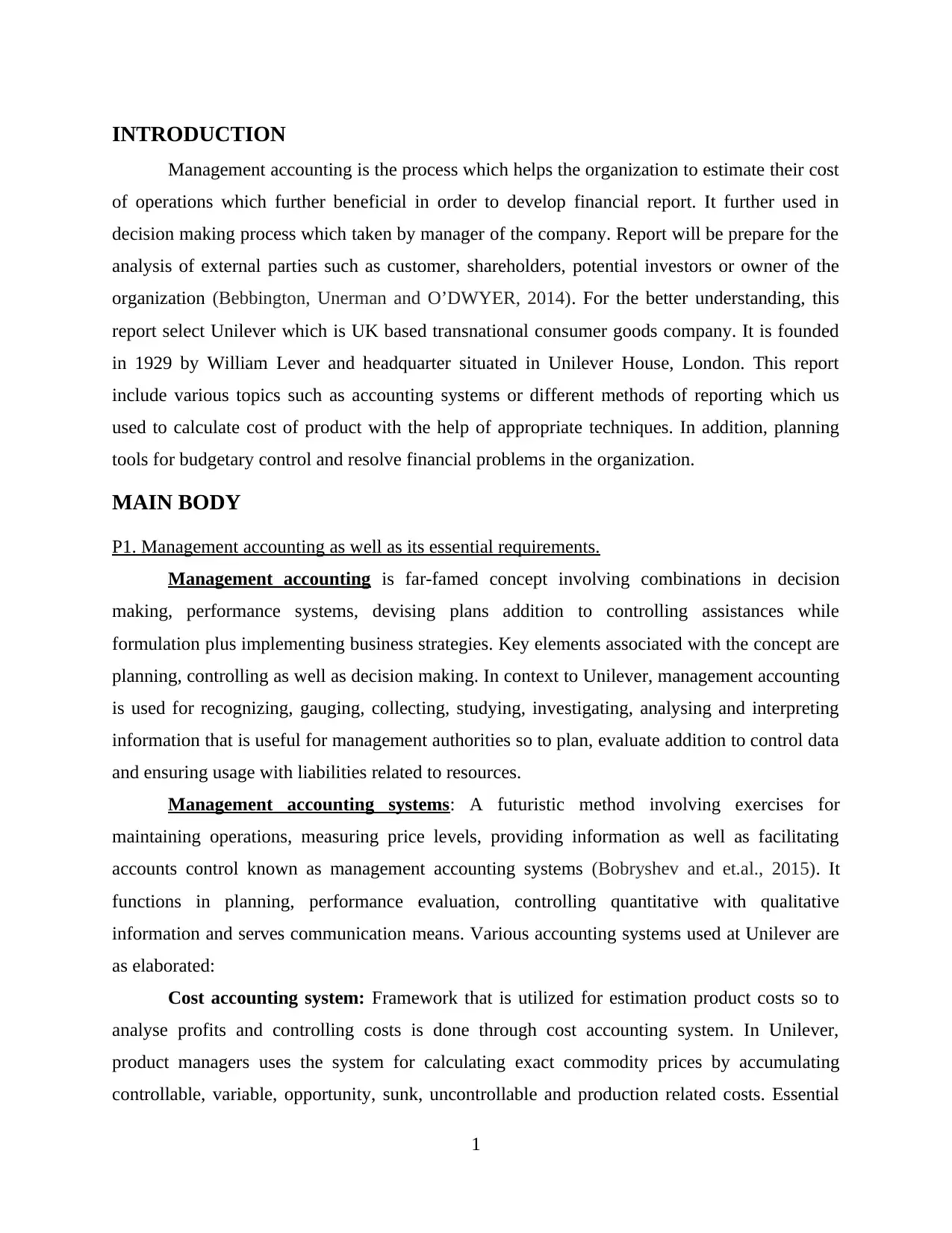
INTRODUCTION
Management accounting is the process which helps the organization to estimate their cost
of operations which further beneficial in order to develop financial report. It further used in
decision making process which taken by manager of the company. Report will be prepare for the
analysis of external parties such as customer, shareholders, potential investors or owner of the
organization (Bebbington, Unerman and O’DWYER, 2014). For the better understanding, this
report select Unilever which is UK based transnational consumer goods company. It is founded
in 1929 by William Lever and headquarter situated in Unilever House, London. This report
include various topics such as accounting systems or different methods of reporting which us
used to calculate cost of product with the help of appropriate techniques. In addition, planning
tools for budgetary control and resolve financial problems in the organization.
MAIN BODY
P1. Management accounting as well as its essential requirements.
Management accounting is far-famed concept involving combinations in decision
making, performance systems, devising plans addition to controlling assistances while
formulation plus implementing business strategies. Key elements associated with the concept are
planning, controlling as well as decision making. In context to Unilever, management accounting
is used for recognizing, gauging, collecting, studying, investigating, analysing and interpreting
information that is useful for management authorities so to plan, evaluate addition to control data
and ensuring usage with liabilities related to resources.
Management accounting systems: A futuristic method involving exercises for
maintaining operations, measuring price levels, providing information as well as facilitating
accounts control known as management accounting systems (Bobryshev and et.al., 2015). It
functions in planning, performance evaluation, controlling quantitative with qualitative
information and serves communication means. Various accounting systems used at Unilever are
as elaborated:
Cost accounting system: Framework that is utilized for estimation product costs so to
analyse profits and controlling costs is done through cost accounting system. In Unilever,
product managers uses the system for calculating exact commodity prices by accumulating
controllable, variable, opportunity, sunk, uncontrollable and production related costs. Essential
1
Management accounting is the process which helps the organization to estimate their cost
of operations which further beneficial in order to develop financial report. It further used in
decision making process which taken by manager of the company. Report will be prepare for the
analysis of external parties such as customer, shareholders, potential investors or owner of the
organization (Bebbington, Unerman and O’DWYER, 2014). For the better understanding, this
report select Unilever which is UK based transnational consumer goods company. It is founded
in 1929 by William Lever and headquarter situated in Unilever House, London. This report
include various topics such as accounting systems or different methods of reporting which us
used to calculate cost of product with the help of appropriate techniques. In addition, planning
tools for budgetary control and resolve financial problems in the organization.
MAIN BODY
P1. Management accounting as well as its essential requirements.
Management accounting is far-famed concept involving combinations in decision
making, performance systems, devising plans addition to controlling assistances while
formulation plus implementing business strategies. Key elements associated with the concept are
planning, controlling as well as decision making. In context to Unilever, management accounting
is used for recognizing, gauging, collecting, studying, investigating, analysing and interpreting
information that is useful for management authorities so to plan, evaluate addition to control data
and ensuring usage with liabilities related to resources.
Management accounting systems: A futuristic method involving exercises for
maintaining operations, measuring price levels, providing information as well as facilitating
accounts control known as management accounting systems (Bobryshev and et.al., 2015). It
functions in planning, performance evaluation, controlling quantitative with qualitative
information and serves communication means. Various accounting systems used at Unilever are
as elaborated:
Cost accounting system: Framework that is utilized for estimation product costs so to
analyse profits and controlling costs is done through cost accounting system. In Unilever,
product managers uses the system for calculating exact commodity prices by accumulating
controllable, variable, opportunity, sunk, uncontrollable and production related costs. Essential
1
⊘ This is a preview!⊘
Do you want full access?
Subscribe today to unlock all pages.

Trusted by 1+ million students worldwide
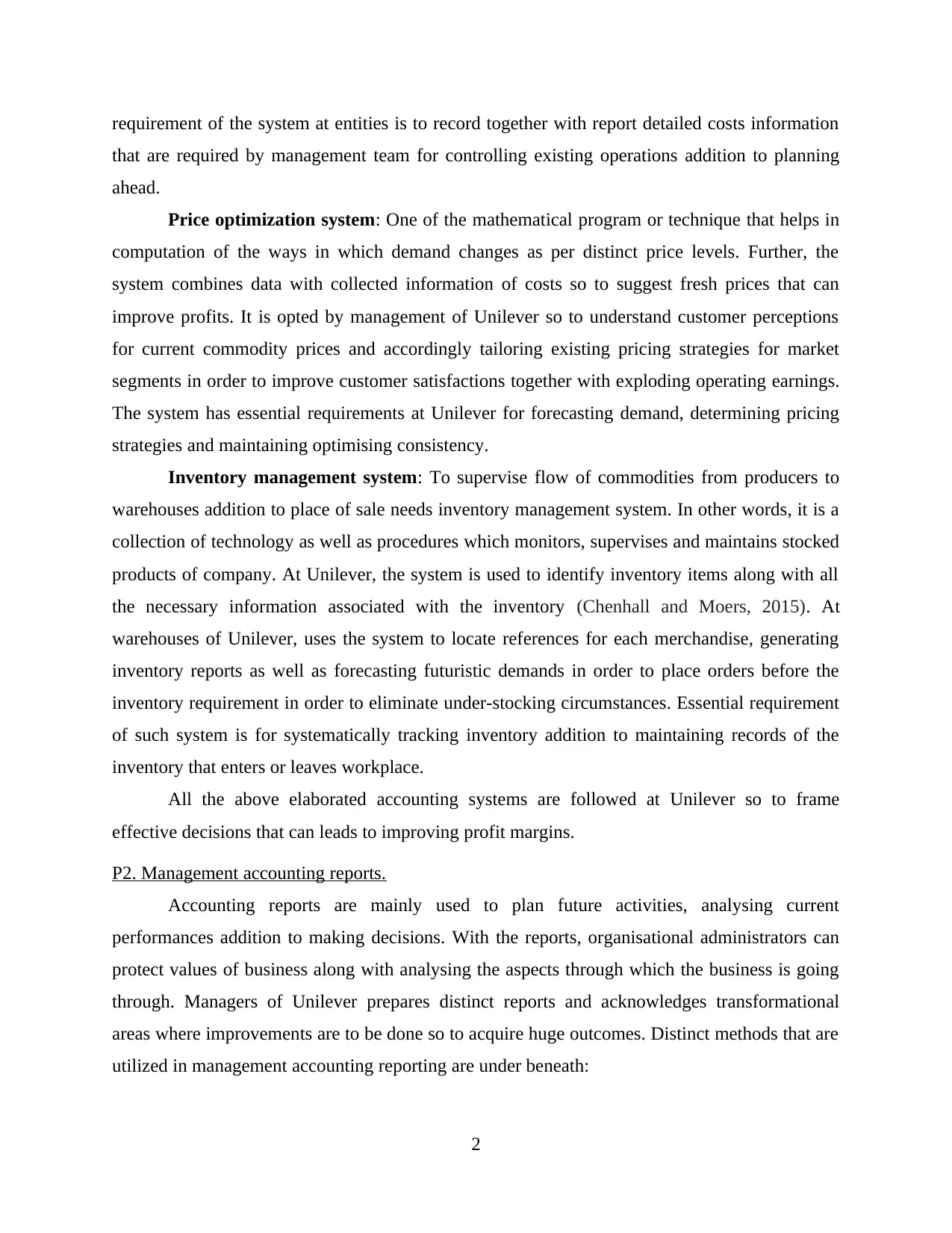
requirement of the system at entities is to record together with report detailed costs information
that are required by management team for controlling existing operations addition to planning
ahead.
Price optimization system: One of the mathematical program or technique that helps in
computation of the ways in which demand changes as per distinct price levels. Further, the
system combines data with collected information of costs so to suggest fresh prices that can
improve profits. It is opted by management of Unilever so to understand customer perceptions
for current commodity prices and accordingly tailoring existing pricing strategies for market
segments in order to improve customer satisfactions together with exploding operating earnings.
The system has essential requirements at Unilever for forecasting demand, determining pricing
strategies and maintaining optimising consistency.
Inventory management system: To supervise flow of commodities from producers to
warehouses addition to place of sale needs inventory management system. In other words, it is a
collection of technology as well as procedures which monitors, supervises and maintains stocked
products of company. At Unilever, the system is used to identify inventory items along with all
the necessary information associated with the inventory (Chenhall and Moers, 2015). At
warehouses of Unilever, uses the system to locate references for each merchandise, generating
inventory reports as well as forecasting futuristic demands in order to place orders before the
inventory requirement in order to eliminate under-stocking circumstances. Essential requirement
of such system is for systematically tracking inventory addition to maintaining records of the
inventory that enters or leaves workplace.
All the above elaborated accounting systems are followed at Unilever so to frame
effective decisions that can leads to improving profit margins.
P2. Management accounting reports.
Accounting reports are mainly used to plan future activities, analysing current
performances addition to making decisions. With the reports, organisational administrators can
protect values of business along with analysing the aspects through which the business is going
through. Managers of Unilever prepares distinct reports and acknowledges transformational
areas where improvements are to be done so to acquire huge outcomes. Distinct methods that are
utilized in management accounting reporting are under beneath:
2
that are required by management team for controlling existing operations addition to planning
ahead.
Price optimization system: One of the mathematical program or technique that helps in
computation of the ways in which demand changes as per distinct price levels. Further, the
system combines data with collected information of costs so to suggest fresh prices that can
improve profits. It is opted by management of Unilever so to understand customer perceptions
for current commodity prices and accordingly tailoring existing pricing strategies for market
segments in order to improve customer satisfactions together with exploding operating earnings.
The system has essential requirements at Unilever for forecasting demand, determining pricing
strategies and maintaining optimising consistency.
Inventory management system: To supervise flow of commodities from producers to
warehouses addition to place of sale needs inventory management system. In other words, it is a
collection of technology as well as procedures which monitors, supervises and maintains stocked
products of company. At Unilever, the system is used to identify inventory items along with all
the necessary information associated with the inventory (Chenhall and Moers, 2015). At
warehouses of Unilever, uses the system to locate references for each merchandise, generating
inventory reports as well as forecasting futuristic demands in order to place orders before the
inventory requirement in order to eliminate under-stocking circumstances. Essential requirement
of such system is for systematically tracking inventory addition to maintaining records of the
inventory that enters or leaves workplace.
All the above elaborated accounting systems are followed at Unilever so to frame
effective decisions that can leads to improving profit margins.
P2. Management accounting reports.
Accounting reports are mainly used to plan future activities, analysing current
performances addition to making decisions. With the reports, organisational administrators can
protect values of business along with analysing the aspects through which the business is going
through. Managers of Unilever prepares distinct reports and acknowledges transformational
areas where improvements are to be done so to acquire huge outcomes. Distinct methods that are
utilized in management accounting reporting are under beneath:
2
Paraphrase This Document
Need a fresh take? Get an instant paraphrase of this document with our AI Paraphraser
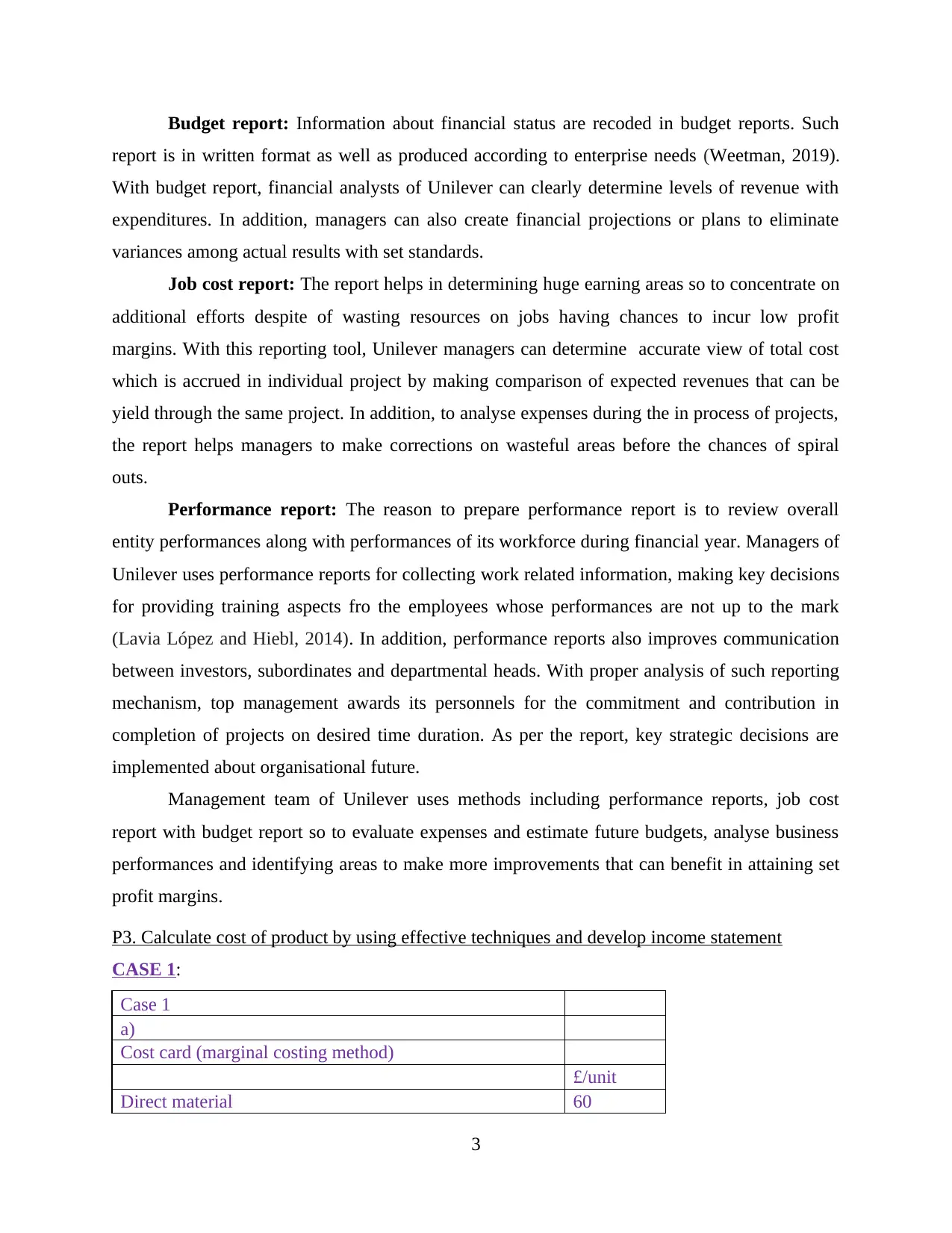
Budget report: Information about financial status are recoded in budget reports. Such
report is in written format as well as produced according to enterprise needs (Weetman, 2019).
With budget report, financial analysts of Unilever can clearly determine levels of revenue with
expenditures. In addition, managers can also create financial projections or plans to eliminate
variances among actual results with set standards.
Job cost report: The report helps in determining huge earning areas so to concentrate on
additional efforts despite of wasting resources on jobs having chances to incur low profit
margins. With this reporting tool, Unilever managers can determine accurate view of total cost
which is accrued in individual project by making comparison of expected revenues that can be
yield through the same project. In addition, to analyse expenses during the in process of projects,
the report helps managers to make corrections on wasteful areas before the chances of spiral
outs.
Performance report: The reason to prepare performance report is to review overall
entity performances along with performances of its workforce during financial year. Managers of
Unilever uses performance reports for collecting work related information, making key decisions
for providing training aspects fro the employees whose performances are not up to the mark
(Lavia López and Hiebl, 2014). In addition, performance reports also improves communication
between investors, subordinates and departmental heads. With proper analysis of such reporting
mechanism, top management awards its personnels for the commitment and contribution in
completion of projects on desired time duration. As per the report, key strategic decisions are
implemented about organisational future.
Management team of Unilever uses methods including performance reports, job cost
report with budget report so to evaluate expenses and estimate future budgets, analyse business
performances and identifying areas to make more improvements that can benefit in attaining set
profit margins.
P3. Calculate cost of product by using effective techniques and develop income statement
CASE 1:
Case 1
a)
Cost card (marginal costing method)
£/unit
Direct material 60
3
report is in written format as well as produced according to enterprise needs (Weetman, 2019).
With budget report, financial analysts of Unilever can clearly determine levels of revenue with
expenditures. In addition, managers can also create financial projections or plans to eliminate
variances among actual results with set standards.
Job cost report: The report helps in determining huge earning areas so to concentrate on
additional efforts despite of wasting resources on jobs having chances to incur low profit
margins. With this reporting tool, Unilever managers can determine accurate view of total cost
which is accrued in individual project by making comparison of expected revenues that can be
yield through the same project. In addition, to analyse expenses during the in process of projects,
the report helps managers to make corrections on wasteful areas before the chances of spiral
outs.
Performance report: The reason to prepare performance report is to review overall
entity performances along with performances of its workforce during financial year. Managers of
Unilever uses performance reports for collecting work related information, making key decisions
for providing training aspects fro the employees whose performances are not up to the mark
(Lavia López and Hiebl, 2014). In addition, performance reports also improves communication
between investors, subordinates and departmental heads. With proper analysis of such reporting
mechanism, top management awards its personnels for the commitment and contribution in
completion of projects on desired time duration. As per the report, key strategic decisions are
implemented about organisational future.
Management team of Unilever uses methods including performance reports, job cost
report with budget report so to evaluate expenses and estimate future budgets, analyse business
performances and identifying areas to make more improvements that can benefit in attaining set
profit margins.
P3. Calculate cost of product by using effective techniques and develop income statement
CASE 1:
Case 1
a)
Cost card (marginal costing method)
£/unit
Direct material 60
3
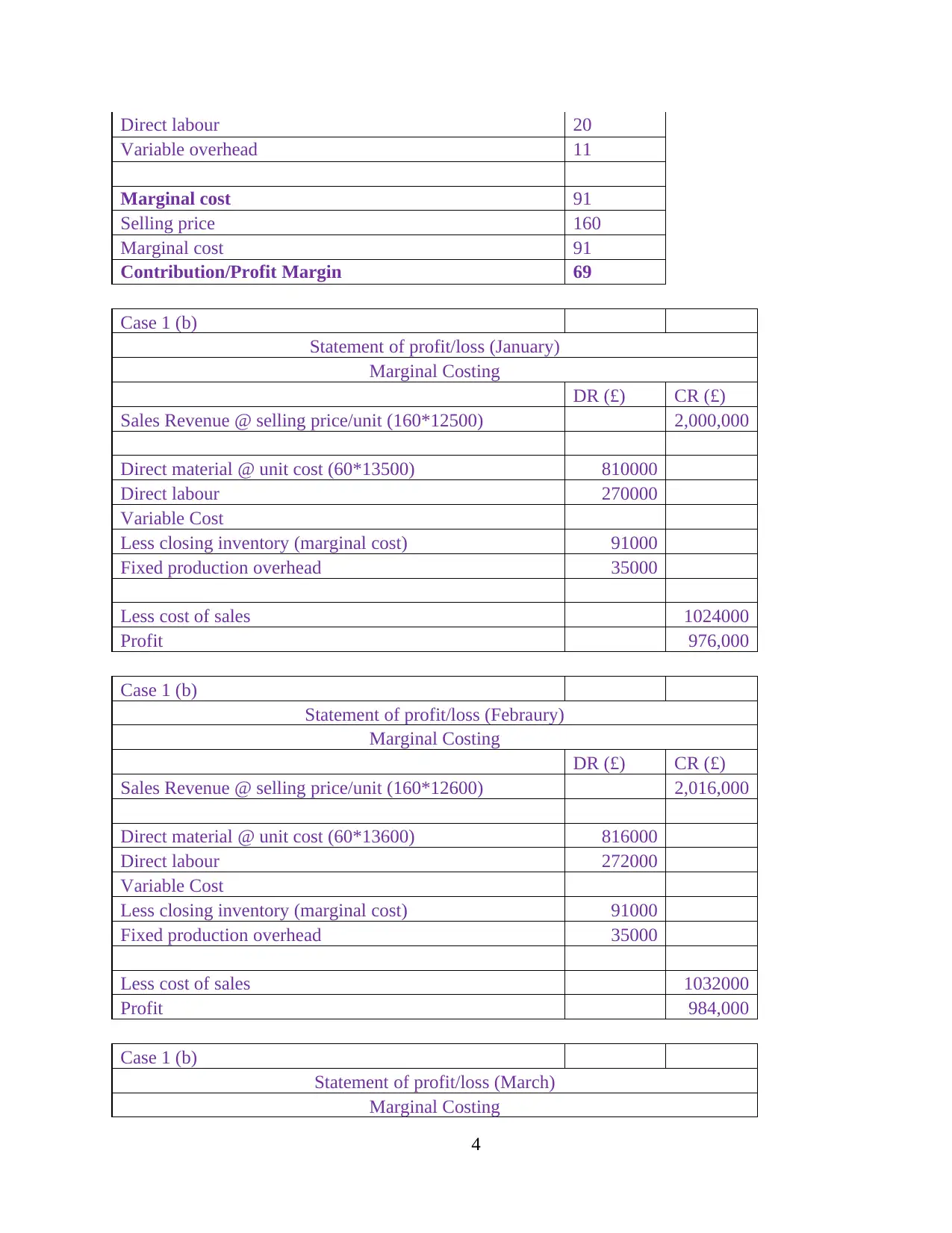
Direct labour 20
Variable overhead 11
Marginal cost 91
Selling price 160
Marginal cost 91
Contribution/Profit Margin 69
Case 1 (b)
Statement of profit/loss (January)
Marginal Costing
DR (£) CR (£)
Sales Revenue @ selling price/unit (160*12500) 2,000,000
Direct material @ unit cost (60*13500) 810000
Direct labour 270000
Variable Cost
Less closing inventory (marginal cost) 91000
Fixed production overhead 35000
Less cost of sales 1024000
Profit 976,000
Case 1 (b)
Statement of profit/loss (Febraury)
Marginal Costing
DR (£) CR (£)
Sales Revenue @ selling price/unit (160*12600) 2,016,000
Direct material @ unit cost (60*13600) 816000
Direct labour 272000
Variable Cost
Less closing inventory (marginal cost) 91000
Fixed production overhead 35000
Less cost of sales 1032000
Profit 984,000
Case 1 (b)
Statement of profit/loss (March)
Marginal Costing
4
Variable overhead 11
Marginal cost 91
Selling price 160
Marginal cost 91
Contribution/Profit Margin 69
Case 1 (b)
Statement of profit/loss (January)
Marginal Costing
DR (£) CR (£)
Sales Revenue @ selling price/unit (160*12500) 2,000,000
Direct material @ unit cost (60*13500) 810000
Direct labour 270000
Variable Cost
Less closing inventory (marginal cost) 91000
Fixed production overhead 35000
Less cost of sales 1024000
Profit 976,000
Case 1 (b)
Statement of profit/loss (Febraury)
Marginal Costing
DR (£) CR (£)
Sales Revenue @ selling price/unit (160*12600) 2,016,000
Direct material @ unit cost (60*13600) 816000
Direct labour 272000
Variable Cost
Less closing inventory (marginal cost) 91000
Fixed production overhead 35000
Less cost of sales 1032000
Profit 984,000
Case 1 (b)
Statement of profit/loss (March)
Marginal Costing
4
⊘ This is a preview!⊘
Do you want full access?
Subscribe today to unlock all pages.

Trusted by 1+ million students worldwide
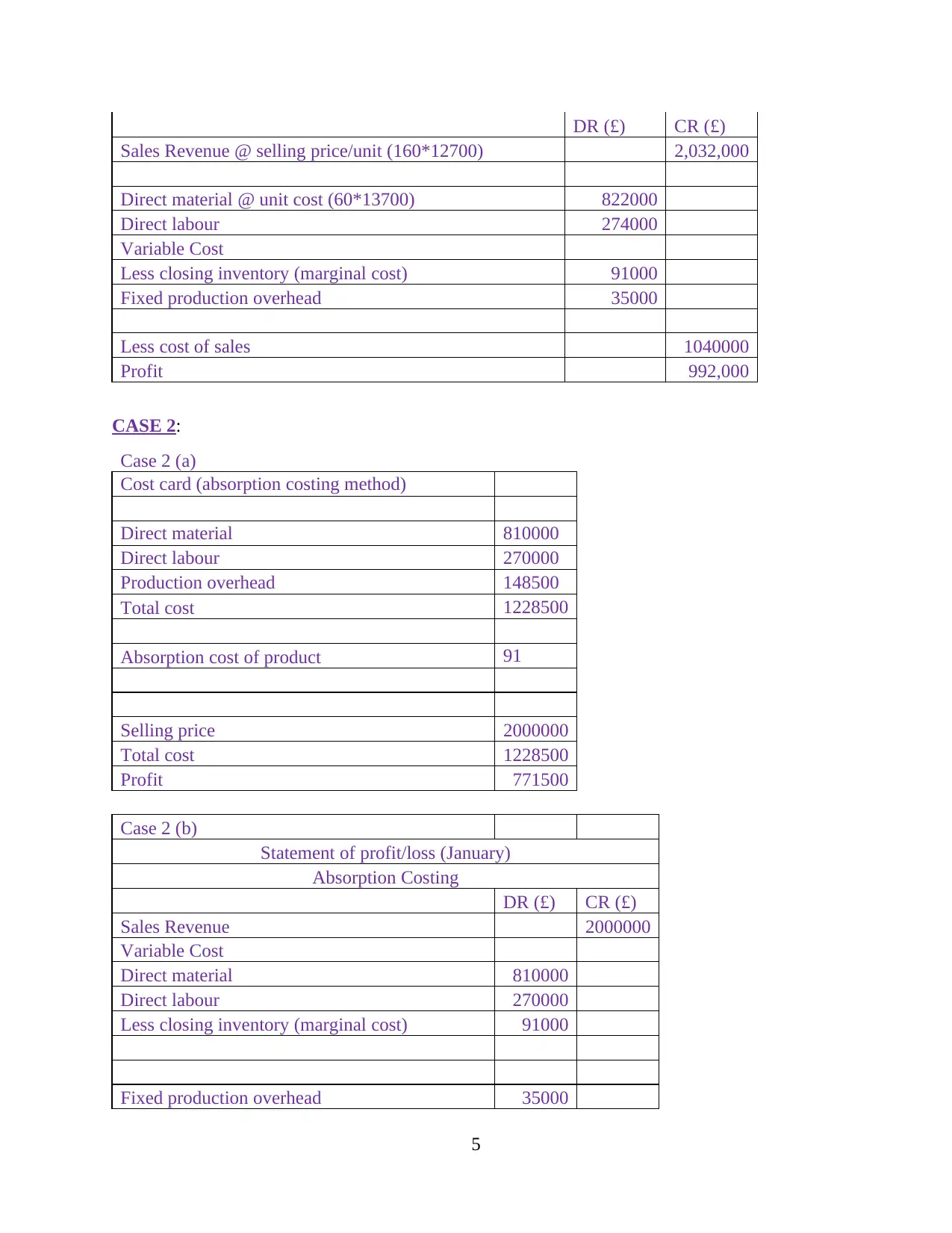
DR (£) CR (£)
Sales Revenue @ selling price/unit (160*12700) 2,032,000
Direct material @ unit cost (60*13700) 822000
Direct labour 274000
Variable Cost
Less closing inventory (marginal cost) 91000
Fixed production overhead 35000
Less cost of sales 1040000
Profit 992,000
CASE 2:
Case 2 (a)
Cost card (absorption costing method)
Direct material 810000
Direct labour 270000
Production overhead 148500
Total cost 1228500
Absorption cost of product 91
Selling price 2000000
Total cost 1228500
Profit 771500
Case 2 (b)
Statement of profit/loss (January)
Absorption Costing
DR (£) CR (£)
Sales Revenue 2000000
Variable Cost
Direct material 810000
Direct labour 270000
Less closing inventory (marginal cost) 91000
Fixed production overhead 35000
5
Sales Revenue @ selling price/unit (160*12700) 2,032,000
Direct material @ unit cost (60*13700) 822000
Direct labour 274000
Variable Cost
Less closing inventory (marginal cost) 91000
Fixed production overhead 35000
Less cost of sales 1040000
Profit 992,000
CASE 2:
Case 2 (a)
Cost card (absorption costing method)
Direct material 810000
Direct labour 270000
Production overhead 148500
Total cost 1228500
Absorption cost of product 91
Selling price 2000000
Total cost 1228500
Profit 771500
Case 2 (b)
Statement of profit/loss (January)
Absorption Costing
DR (£) CR (£)
Sales Revenue 2000000
Variable Cost
Direct material 810000
Direct labour 270000
Less closing inventory (marginal cost) 91000
Fixed production overhead 35000
5
Paraphrase This Document
Need a fresh take? Get an instant paraphrase of this document with our AI Paraphraser
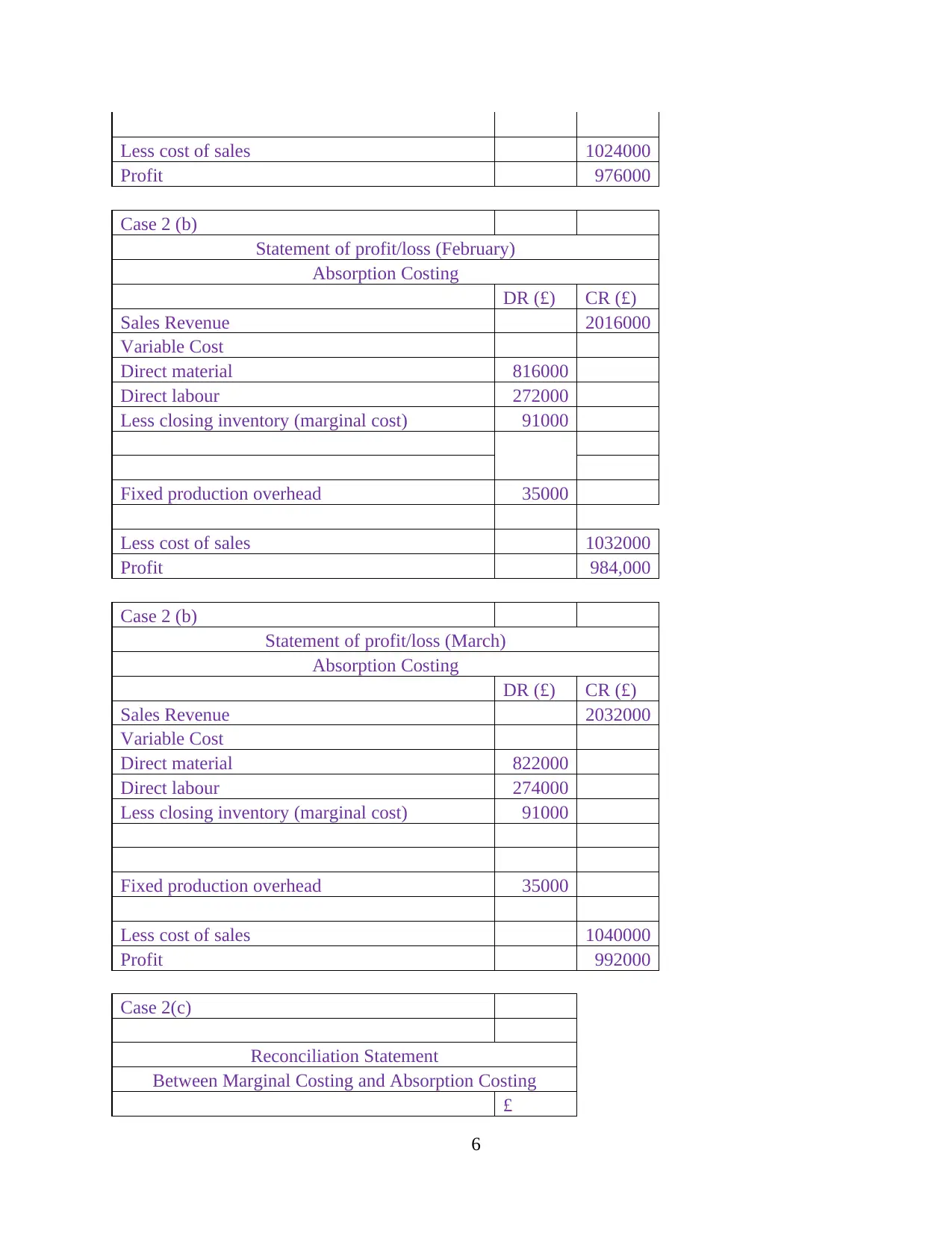
Less cost of sales 1024000
Profit 976000
Case 2 (b)
Statement of profit/loss (February)
Absorption Costing
DR (£) CR (£)
Sales Revenue 2016000
Variable Cost
Direct material 816000
Direct labour 272000
Less closing inventory (marginal cost) 91000
Fixed production overhead 35000
Less cost of sales 1032000
Profit 984,000
Case 2 (b)
Statement of profit/loss (March)
Absorption Costing
DR (£) CR (£)
Sales Revenue 2032000
Variable Cost
Direct material 822000
Direct labour 274000
Less closing inventory (marginal cost) 91000
Fixed production overhead 35000
Less cost of sales 1040000
Profit 992000
Case 2(c)
Reconciliation Statement
Between Marginal Costing and Absorption Costing
£
6
Profit 976000
Case 2 (b)
Statement of profit/loss (February)
Absorption Costing
DR (£) CR (£)
Sales Revenue 2016000
Variable Cost
Direct material 816000
Direct labour 272000
Less closing inventory (marginal cost) 91000
Fixed production overhead 35000
Less cost of sales 1032000
Profit 984,000
Case 2 (b)
Statement of profit/loss (March)
Absorption Costing
DR (£) CR (£)
Sales Revenue 2032000
Variable Cost
Direct material 822000
Direct labour 274000
Less closing inventory (marginal cost) 91000
Fixed production overhead 35000
Less cost of sales 1040000
Profit 992000
Case 2(c)
Reconciliation Statement
Between Marginal Costing and Absorption Costing
£
6
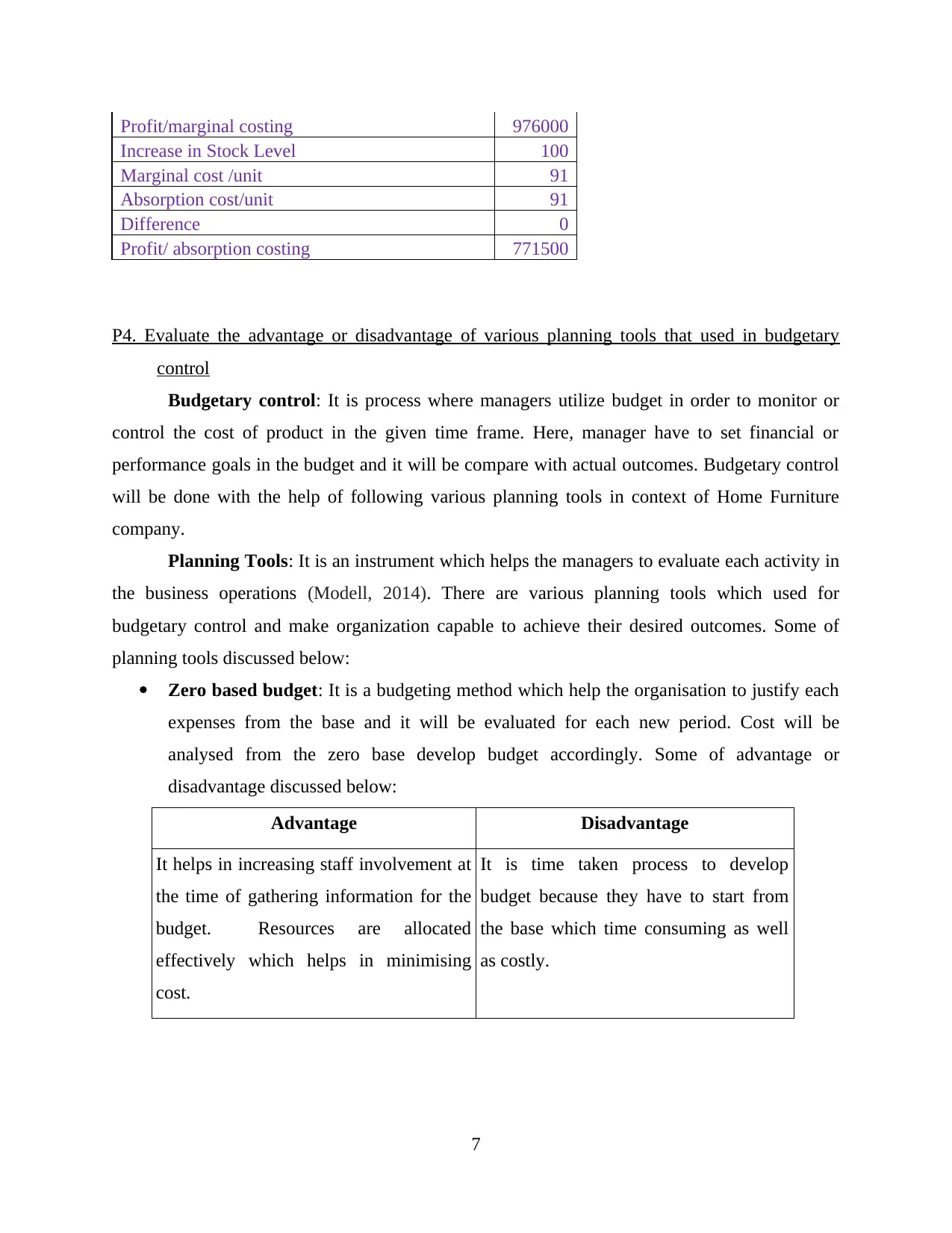
Profit/marginal costing 976000
Increase in Stock Level 100
Marginal cost /unit 91
Absorption cost/unit 91
Difference 0
Profit/ absorption costing 771500
P4. Evaluate the advantage or disadvantage of various planning tools that used in budgetary
control
Budgetary control: It is process where managers utilize budget in order to monitor or
control the cost of product in the given time frame. Here, manager have to set financial or
performance goals in the budget and it will be compare with actual outcomes. Budgetary control
will be done with the help of following various planning tools in context of Home Furniture
company.
Planning Tools: It is an instrument which helps the managers to evaluate each activity in
the business operations (Modell, 2014). There are various planning tools which used for
budgetary control and make organization capable to achieve their desired outcomes. Some of
planning tools discussed below:
Zero based budget: It is a budgeting method which help the organisation to justify each
expenses from the base and it will be evaluated for each new period. Cost will be
analysed from the zero base develop budget accordingly. Some of advantage or
disadvantage discussed below:
Advantage Disadvantage
It helps in increasing staff involvement at
the time of gathering information for the
budget. Resources are allocated
effectively which helps in minimising
cost.
It is time taken process to develop
budget because they have to start from
the base which time consuming as well
as costly.
7
Increase in Stock Level 100
Marginal cost /unit 91
Absorption cost/unit 91
Difference 0
Profit/ absorption costing 771500
P4. Evaluate the advantage or disadvantage of various planning tools that used in budgetary
control
Budgetary control: It is process where managers utilize budget in order to monitor or
control the cost of product in the given time frame. Here, manager have to set financial or
performance goals in the budget and it will be compare with actual outcomes. Budgetary control
will be done with the help of following various planning tools in context of Home Furniture
company.
Planning Tools: It is an instrument which helps the managers to evaluate each activity in
the business operations (Modell, 2014). There are various planning tools which used for
budgetary control and make organization capable to achieve their desired outcomes. Some of
planning tools discussed below:
Zero based budget: It is a budgeting method which help the organisation to justify each
expenses from the base and it will be evaluated for each new period. Cost will be
analysed from the zero base develop budget accordingly. Some of advantage or
disadvantage discussed below:
Advantage Disadvantage
It helps in increasing staff involvement at
the time of gathering information for the
budget. Resources are allocated
effectively which helps in minimising
cost.
It is time taken process to develop
budget because they have to start from
the base which time consuming as well
as costly.
7
⊘ This is a preview!⊘
Do you want full access?
Subscribe today to unlock all pages.

Trusted by 1+ million students worldwide
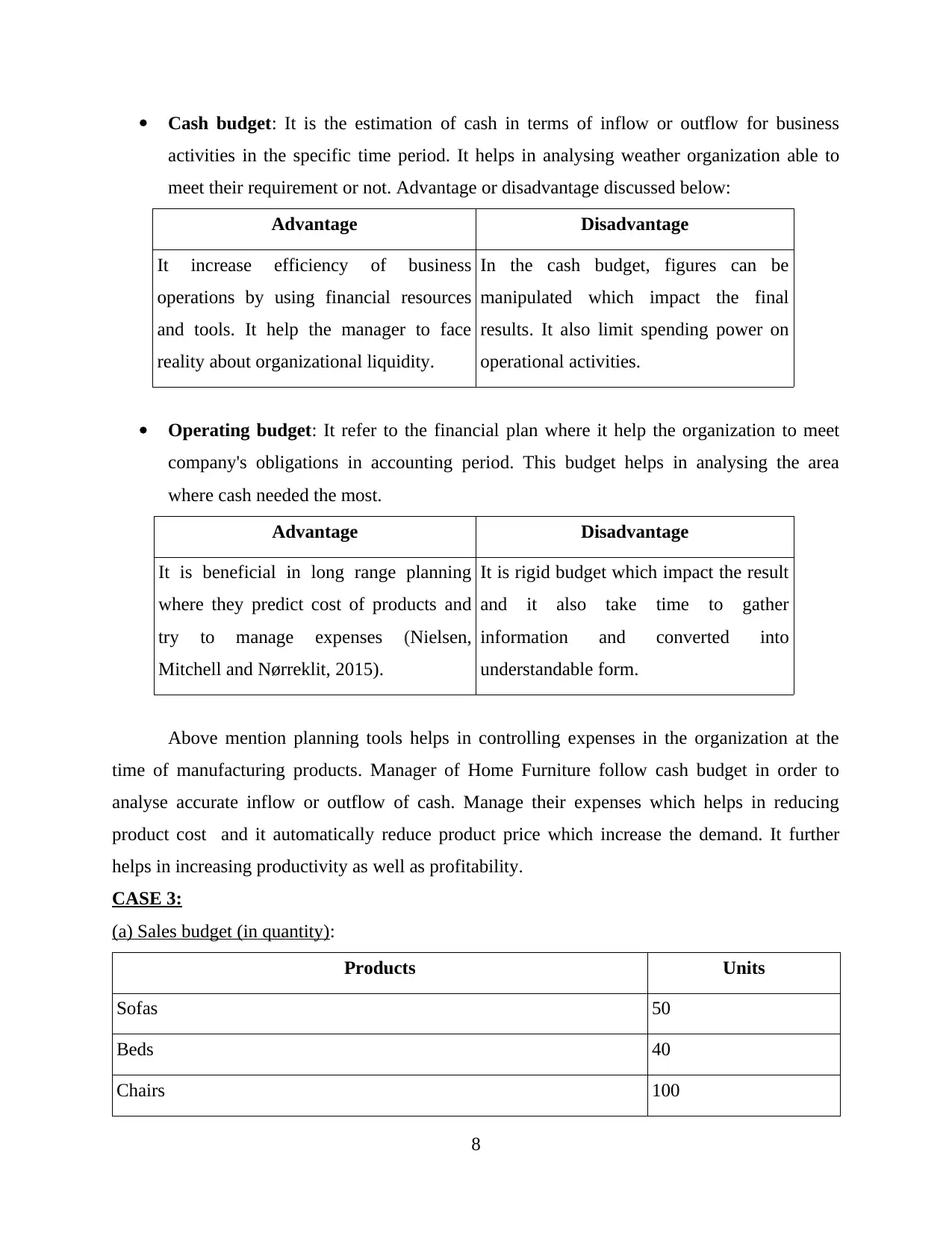
Cash budget: It is the estimation of cash in terms of inflow or outflow for business
activities in the specific time period. It helps in analysing weather organization able to
meet their requirement or not. Advantage or disadvantage discussed below:
Advantage Disadvantage
It increase efficiency of business
operations by using financial resources
and tools. It help the manager to face
reality about organizational liquidity.
In the cash budget, figures can be
manipulated which impact the final
results. It also limit spending power on
operational activities.
Operating budget: It refer to the financial plan where it help the organization to meet
company's obligations in accounting period. This budget helps in analysing the area
where cash needed the most.
Advantage Disadvantage
It is beneficial in long range planning
where they predict cost of products and
try to manage expenses (Nielsen,
Mitchell and Nørreklit, 2015).
It is rigid budget which impact the result
and it also take time to gather
information and converted into
understandable form.
Above mention planning tools helps in controlling expenses in the organization at the
time of manufacturing products. Manager of Home Furniture follow cash budget in order to
analyse accurate inflow or outflow of cash. Manage their expenses which helps in reducing
product cost and it automatically reduce product price which increase the demand. It further
helps in increasing productivity as well as profitability.
CASE 3:
(a) Sales budget (in quantity):
Products Units
Sofas 50
Beds 40
Chairs 100
8
activities in the specific time period. It helps in analysing weather organization able to
meet their requirement or not. Advantage or disadvantage discussed below:
Advantage Disadvantage
It increase efficiency of business
operations by using financial resources
and tools. It help the manager to face
reality about organizational liquidity.
In the cash budget, figures can be
manipulated which impact the final
results. It also limit spending power on
operational activities.
Operating budget: It refer to the financial plan where it help the organization to meet
company's obligations in accounting period. This budget helps in analysing the area
where cash needed the most.
Advantage Disadvantage
It is beneficial in long range planning
where they predict cost of products and
try to manage expenses (Nielsen,
Mitchell and Nørreklit, 2015).
It is rigid budget which impact the result
and it also take time to gather
information and converted into
understandable form.
Above mention planning tools helps in controlling expenses in the organization at the
time of manufacturing products. Manager of Home Furniture follow cash budget in order to
analyse accurate inflow or outflow of cash. Manage their expenses which helps in reducing
product cost and it automatically reduce product price which increase the demand. It further
helps in increasing productivity as well as profitability.
CASE 3:
(a) Sales budget (in quantity):
Products Units
Sofas 50
Beds 40
Chairs 100
8
Paraphrase This Document
Need a fresh take? Get an instant paraphrase of this document with our AI Paraphraser
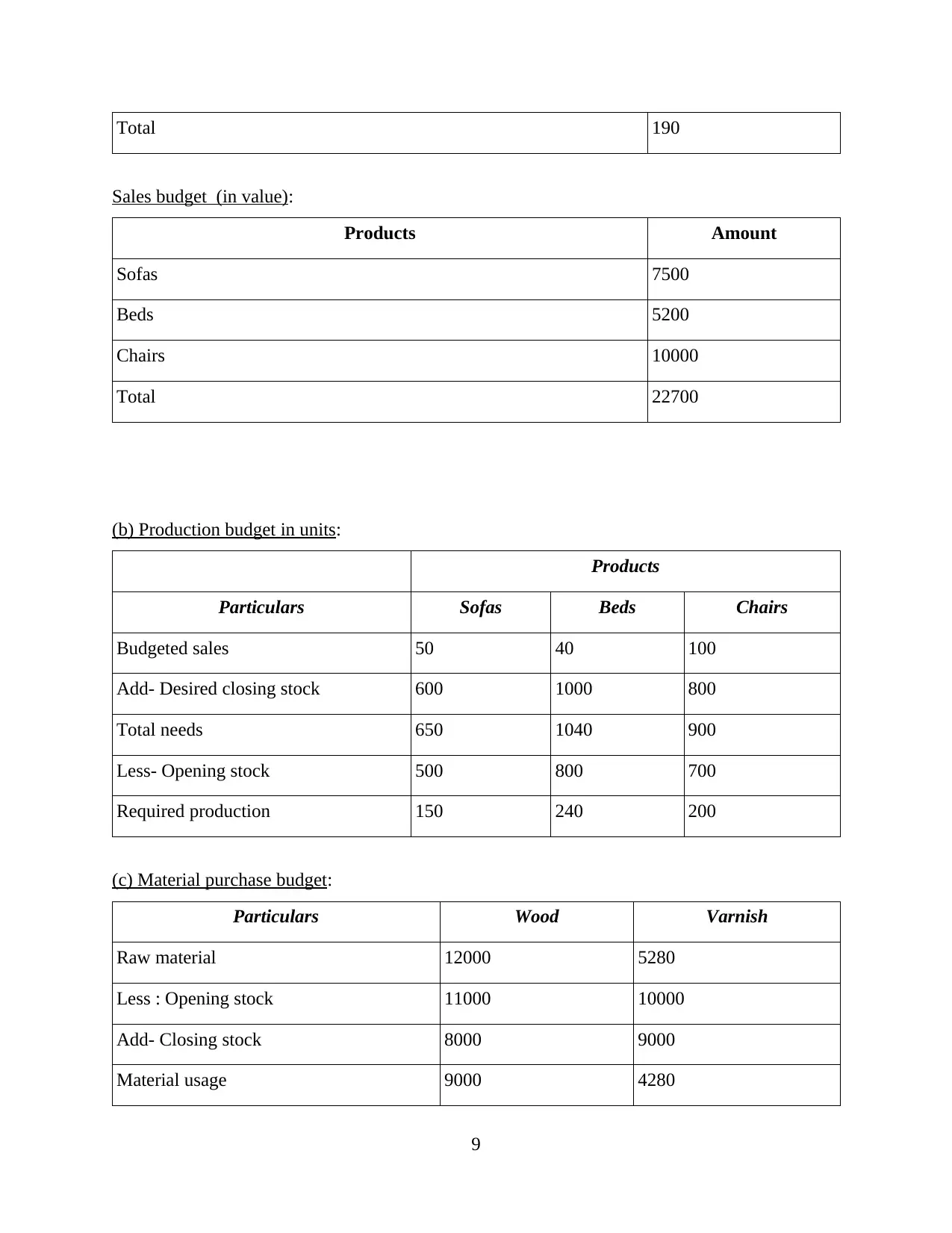
Total 190
Sales budget (in value):
Products Amount
Sofas 7500
Beds 5200
Chairs 10000
Total 22700
(b) Production budget in units:
Products
Particulars Sofas Beds Chairs
Budgeted sales 50 40 100
Add- Desired closing stock 600 1000 800
Total needs 650 1040 900
Less- Opening stock 500 800 700
Required production 150 240 200
(c) Material purchase budget:
Particulars Wood Varnish
Raw material 12000 5280
Less : Opening stock 11000 10000
Add- Closing stock 8000 9000
Material usage 9000 4280
9
Sales budget (in value):
Products Amount
Sofas 7500
Beds 5200
Chairs 10000
Total 22700
(b) Production budget in units:
Products
Particulars Sofas Beds Chairs
Budgeted sales 50 40 100
Add- Desired closing stock 600 1000 800
Total needs 650 1040 900
Less- Opening stock 500 800 700
Required production 150 240 200
(c) Material purchase budget:
Particulars Wood Varnish
Raw material 12000 5280
Less : Opening stock 11000 10000
Add- Closing stock 8000 9000
Material usage 9000 4280
9
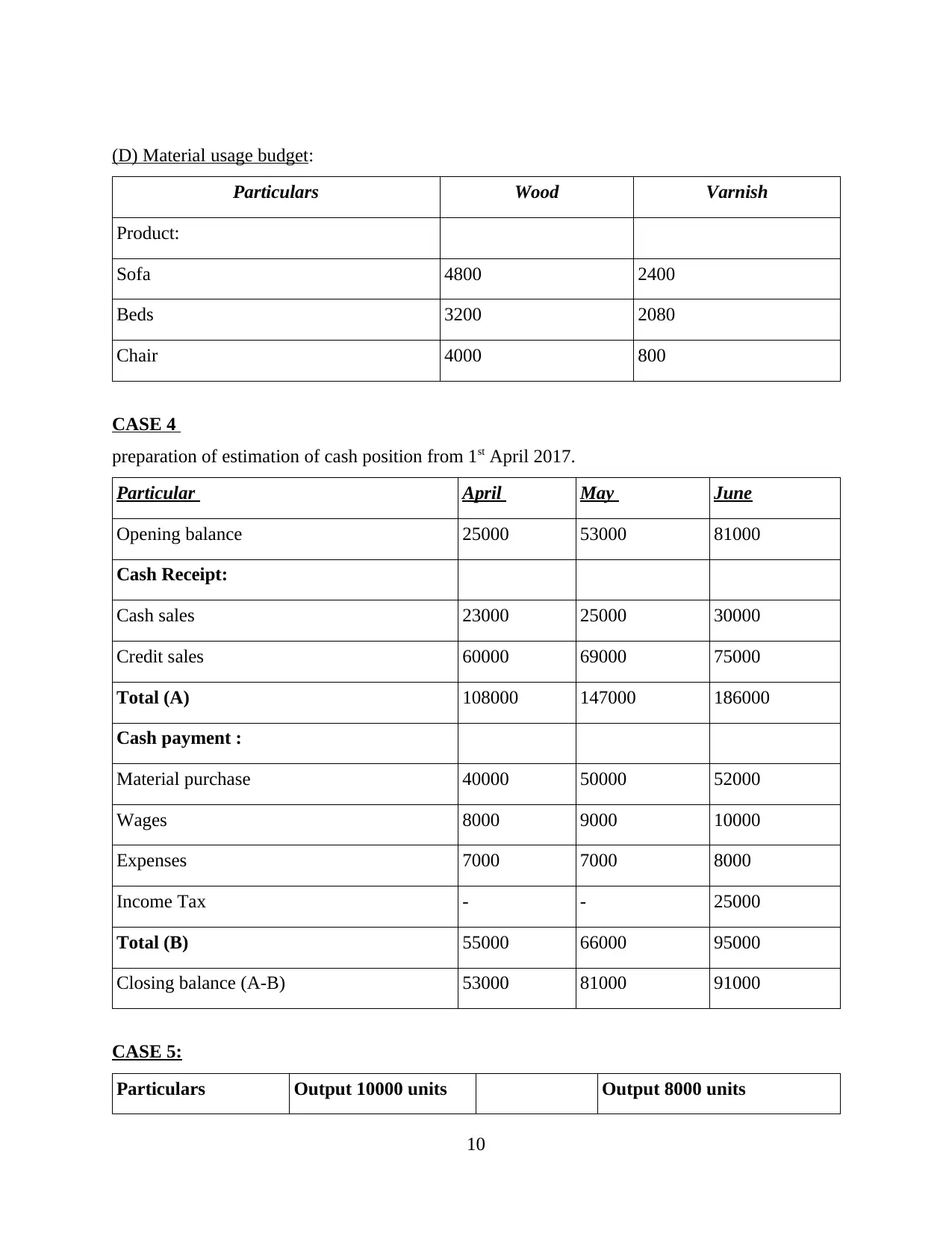
(D) Material usage budget:
Particulars Wood Varnish
Product:
Sofa 4800 2400
Beds 3200 2080
Chair 4000 800
CASE 4
preparation of estimation of cash position from 1st April 2017.
Particular April May June
Opening balance 25000 53000 81000
Cash Receipt:
Cash sales 23000 25000 30000
Credit sales 60000 69000 75000
Total (A) 108000 147000 186000
Cash payment :
Material purchase 40000 50000 52000
Wages 8000 9000 10000
Expenses 7000 7000 8000
Income Tax - - 25000
Total (B) 55000 66000 95000
Closing balance (A-B) 53000 81000 91000
CASE 5:
Particulars Output 10000 units Output 8000 units
10
Particulars Wood Varnish
Product:
Sofa 4800 2400
Beds 3200 2080
Chair 4000 800
CASE 4
preparation of estimation of cash position from 1st April 2017.
Particular April May June
Opening balance 25000 53000 81000
Cash Receipt:
Cash sales 23000 25000 30000
Credit sales 60000 69000 75000
Total (A) 108000 147000 186000
Cash payment :
Material purchase 40000 50000 52000
Wages 8000 9000 10000
Expenses 7000 7000 8000
Income Tax - - 25000
Total (B) 55000 66000 95000
Closing balance (A-B) 53000 81000 91000
CASE 5:
Particulars Output 10000 units Output 8000 units
10
⊘ This is a preview!⊘
Do you want full access?
Subscribe today to unlock all pages.

Trusted by 1+ million students worldwide
1 out of 16
Related Documents
Your All-in-One AI-Powered Toolkit for Academic Success.
+13062052269
info@desklib.com
Available 24*7 on WhatsApp / Email
![[object Object]](/_next/static/media/star-bottom.7253800d.svg)
Unlock your academic potential
Copyright © 2020–2025 A2Z Services. All Rights Reserved. Developed and managed by ZUCOL.





